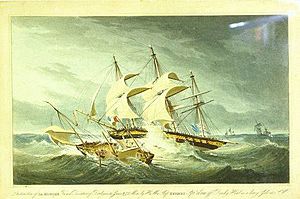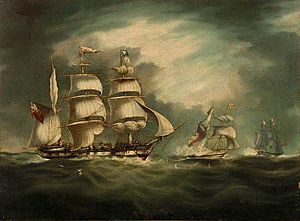HMS Hermes (1811) facts for kids

Hermes
|
|
Quick facts for kids History |
|
|---|---|
| Name | HMS Hermes |
| Ordered | 18 January 1810 |
| Builder | Milford Dockyard |
| Laid down | May 1810 |
| Launched | 22 July 1811 |
| Completed | 7 September 1811 |
| Fate | Grounded in combat and burnt on 15 September 1814 |
| General characteristics | |
| Class and type | 20-gun Hermes-class sixth-rate post ship |
| Tons burthen | 5127⁄94 (bm) |
| Length |
|
| Beam | 31 ft 0 in (9.4 m) |
| Depth of hold | 8 ft 7 in (2.62 m) |
| Sail plan | Full-rigged ship |
| Complement | 135 |
| Armament | 2 x 9-pounder guns + 18 x 32-pounder carronades |
HMS Hermes was a 20-gun warship, part of the Hermes-class. She was built in Milford Dockyard and launched in 1811. Hermes was a fast, flush-decked ship, meaning her main deck was flat from front to back. She was destroyed in 1814 during a battle near Mobile, to prevent her from being captured by American forces after she got stuck.
HMS Hermes in the Napoleonic Wars
In July 1811, Captain Philip Browne took command of Hermes. Her first missions involved capturing American ships that were carrying supplies for the French fleet. She also captured two other ships from New York and Baltimore.
On September 24, 1811, while near Le Havre, France, Hermes recaptured a Prussian ship called Anna Maria. This ship was on its way to London from Lisbon when it was taken by a privateer. A privateer was a ship owned by a private person, but allowed by the government to attack enemy ships during wartime. The privateer that took Anna Maria managed to escape because it was too close to the French coast.
Later that day, strong winds pushed Hermes off course near Beachy Head. Captain Browne then spotted a large French privateer ship, called a lugger, among several English vessels. This privateer had already captured one ship and might have taken more if Hermes hadn't arrived.
After a two-hour chase, the privateer, which had been damaged and had several crew members wounded, surrendered to Hermes. However, as Hermes slowed down, a strong wind broke her main mast and tore her front sail. The privateer immediately tried to escape again. Hermes quickly turned and, despite the strong winds, caught up. Captain Browne decided to sail right next to the privateer to stop it from getting away. Unfortunately, a huge wave caused Hermes to crash into the privateer, sinking it.
Hermes could not launch any rescue boats because of the storm. Only 12 of the privateer's 51 crew members were saved. The privateer was named Mouche from Boulogne, commanded by M. Gageux. It had fourteen guns.
HMS Hermes in the War of 1812
On February 11, 1812, Hermes captured an American ship called Flora. Then, on April 26, she captured another American ship, the Tigress.
Four days later, Hermes and Belle Poule captured an American ship called Gipsy. Gipsy was a "letter of marque" schooner, which meant it was a private ship with government permission to attack enemy ships. She was sailing from New York City to Bordeaux with valuable cargo when the British ships caught her in the middle of the Atlantic Ocean after a three-day chase. Gipsy surrendered twice to Hermes but managed to get away both times before Belle Poule finally captured her.
In late 1812, Hermes was sailing near the Azores islands with two other British warships: the large 74-gun Elephant, commanded by Francis Austen (the brother of famous writer Jane Austen), and the 36-gun frigate Phoebe. On December 27, Elephant and Hermes captured an American privateer schooner named Sword Fish. During an 11-hour chase, Sword Fish threw ten of its sixteen guns overboard to try and escape. The Sword Fish had been sailing for 16 days but hadn't captured any ships.
In April 1814, Captain William Henry Percy took command of Hermes. On August 5, he sailed Hermes with Carron from Havana. They arrived at the mouth of the Apalachicola River eight days later.
Fate of HMS Hermes
In September 1814, Captain Percy led Hermes in an attack on Fort Bowyer, a fort near Mobile. The attack happened on September 15, around 4:30 PM. Two of the four British ships could not get close enough to fire their guns. The fort was much stronger than expected, and the British ships' cannons were not very effective. A land attack by British soldiers also failed.
As Hermes tried to move away, she got stuck in the shallow water right under the fort's guns. To prevent the ship from being captured by the Americans, Captain Percy had his crew leave Hermes in boats from Sophie. Then, they set Hermes on fire. The fire reached her gunpowder storage (magazine) around 10 PM, and the ship exploded. In this battle, Hermes lost 17 sailors who were killed, five who were badly wounded and later died, and 19 who were wounded.
On January 18, 1815, Captain Percy faced a military trial (court martial) for his actions during the battle. The court found him not guilty of any blame. They decided that the difficult situation justified the attack and that everyone involved had acted very bravely.



